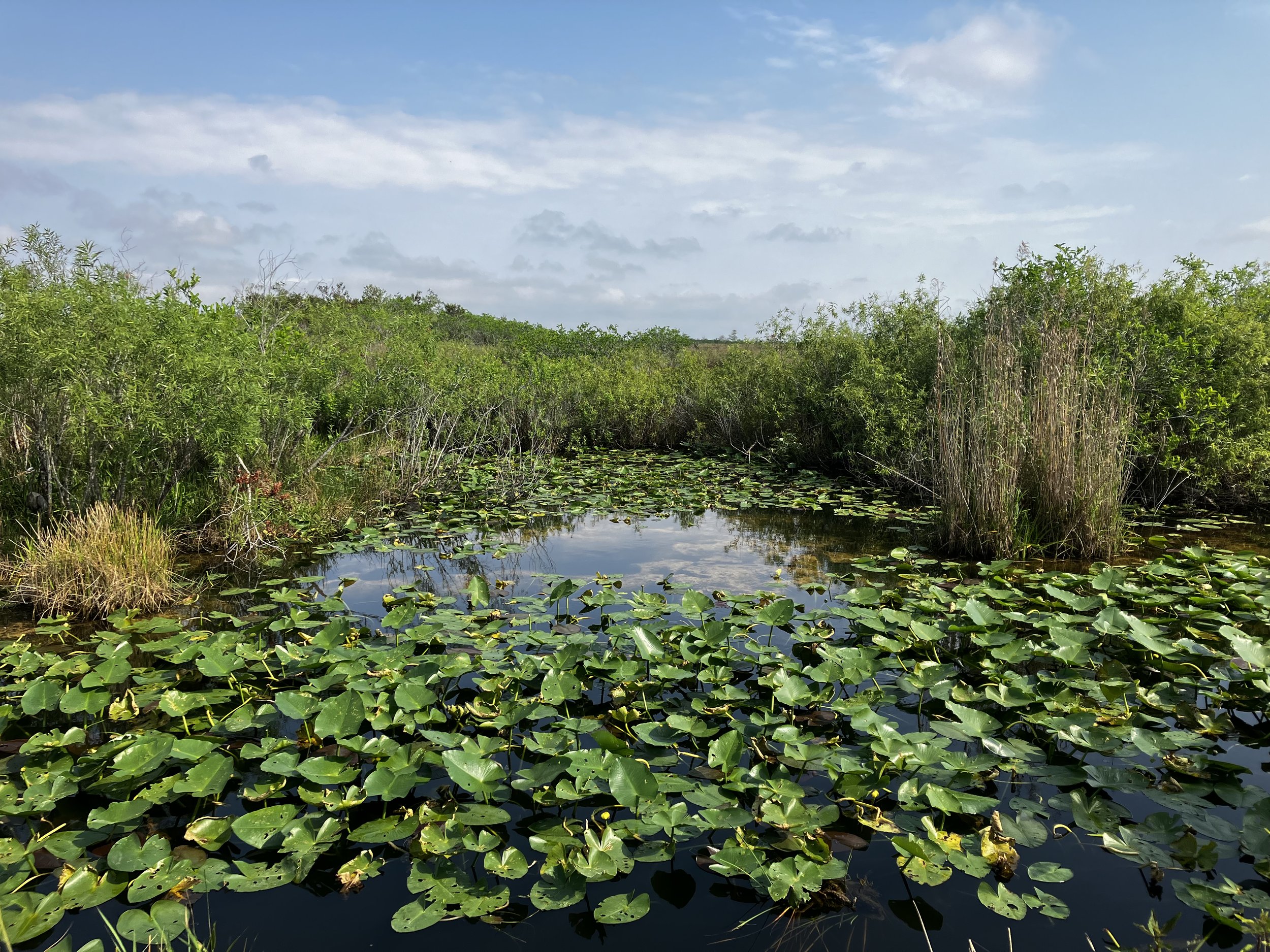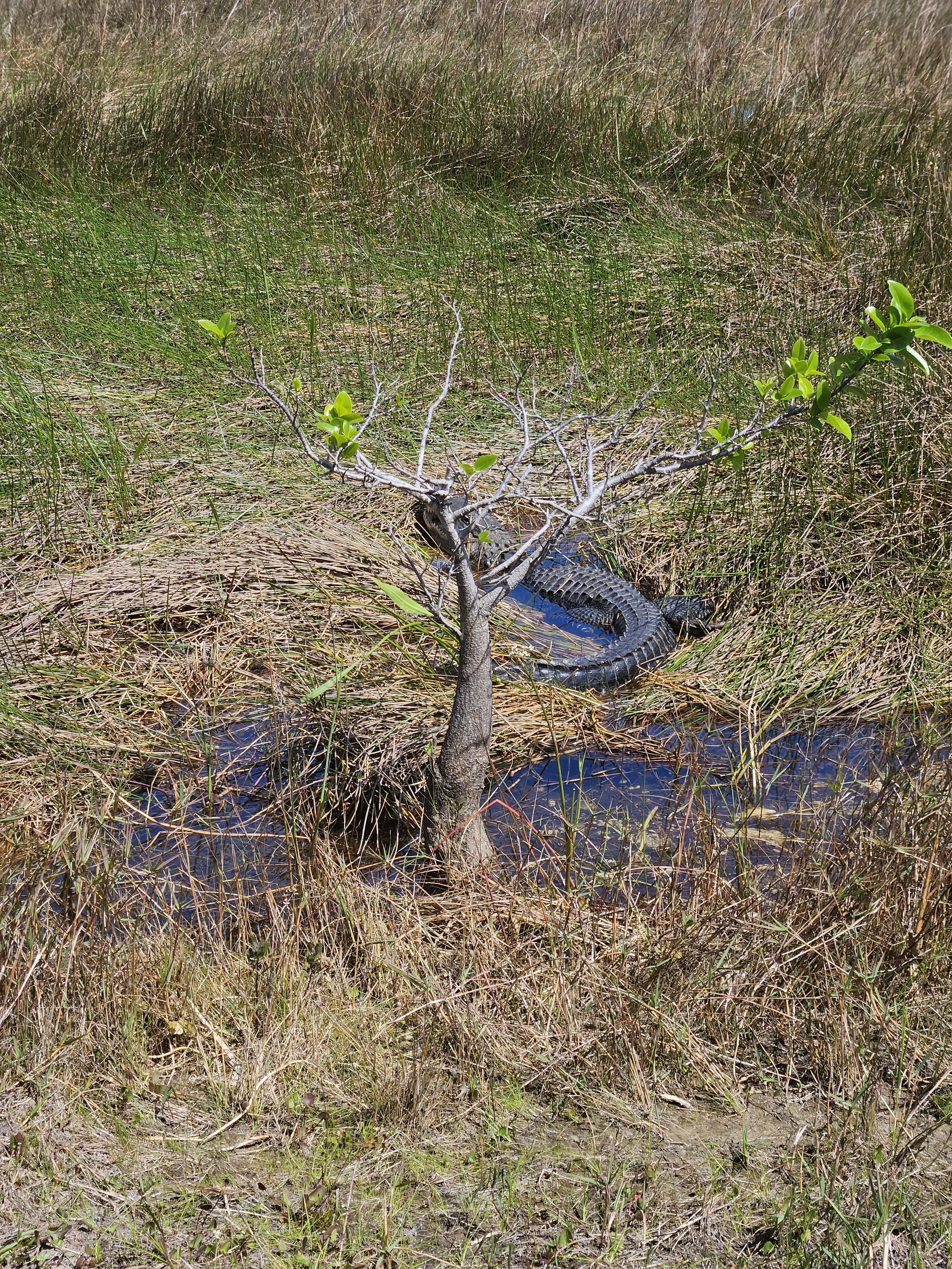Alligator & Crocodile Encounters in Everglades National Park (Florida)
It’s becoming a tradition for me and Ryan to take a camping trip over my school breaks. We roadtripped to Zion last spring break, winter-camped in Vermont over that fall break, and camped a mile out in horror-movie-worthy woods in Congaree National Park the previous year. This year was slightly different in that I was about 12-weeks pregnant, still in the new phase of being unsure how pregnancy might change things as I got further along, and we didn’t want to attempt a trip as demanding in terms of hiking as Zion was, nor did we want to be camping as far off the beaten path as Congaree, since I was waking up for an extra bathroom break in the wee hours of the morning and didn’t want to trek a mile in the dark to the nearest restroom.
We settled on Everglades National Park as our choice for a few reasons. One was that we wanted to be able to use our National Parks Pass but not feel as if we were missing out on hiking opportunities if I was feeling sick or worried about overheating. Another was that the Everglades was on our list already, and this was a perfect time to go, as the mosquitos are not yet terror-cloud-level in mid-March. And finally, the camping was reasonably priced and still had good access to facilities.
Did you know the Everglades is actually a river? The water in the Everglades moves about 100 ft. per day down into Florida Bay. The majority of Florida’s fresh water comes from the Everglades, and drainage of the wetlands and artificial control over Lake Okeechobee to expand urban development has continually threatened access to clean, fresh water for the state; the park was created to protect this resource, as well as the many plants and animals that call this place home. The Everglades contain the largest mangrove ecosystem in the Western Hemisphere, the most significant breeding ground for tropical wading birds in North America, and thirty-six threatened or protected animal species, including the Florida panther, American crocodile, and West Indian manatee. The Everglades are also significant for the number of different ecosystems it contains: freshwater sloughs and marl prairies (low-lying areas covered in water, where the nickname “River of Grass” comes from), tropical hardwood hammocks (islands of subtropical and tropical trees that rise above the sloughs), pine rockland forests, cypress and mangrove systems (Florida’s first and best defense against hurricanes, as they disperse the impact of flood waters and prevent coastal erosion), coastal lowlands (or saltwater marshes), and the marine ecosystem of Florida Bay.
ACCOMMODATIONS: Long Pine Key Campground
We opted to stay at the Long Pine Key Campground, which is just a few miles from the Ernest F. Coe Visitor Center. The other option for front country camping is the Flamingo Campground, which is a much further drive all the way to the coast. We drove down to Flamingo on one of the days we were there, and it made me very glad we chose Long Pine Key, as the area was very marshy (many of the sites overlook the bay directly) and it smelled horribly of birds and fish (though perhaps that was a me-problem from my super-smell pregnancy symptom). Regardless, Long Pine Key was exactly what we’d hoped for: quiet, near a restroom with running water and potable water, with easy access to the trails and main road, and with a spectacular view of the stars at night!
Anhinga Trail (.8 miles round trip)
The first trail we went on was the Anhinga Trail, which is essentially a boardwalk that takes you through a sawgrass marsh. We happened to arrive just when a ranger was departing on a free walking tour, so we joined that—and were happy we did! We learned a lot about the ecosystem of the Everglades, the function of alligator holes, and how to identify different birds. The anhinga, for which the trail is named, is a large water bird with black feathers and a hook-tip bill. Its name comes from an indigenous Brazilian language and means “snake bird,” owing to the fact that it swims with only its neck/head above water and looks like a snake.
This is also the trail where we saw our first alligators! The Everglades are actually in the extreme southern reaches of the range of the American alligator, and the alligators found here are usually on the smaller side (closer to 11 feet for males and 8-9 feet for females). The alligator is a keystone species of the park, and its burrows (alligator holes) provide a refuge for many other animals during the winter dry season. While the alligator can reach up to 35 mph on land and has one of the strongest bite forces in the world, they are actually pretty lazy and don’t generally see humans as prey, as they prefer feeding on small animals that they know they can easily overpower. Most alligator attacks stem from the illegal feeding of alligators, which makes alligators associate humans with food, as well as approaching a female gator’s nest or walking near a gator with a pet (who might be perceived as prey). Unlike wildlife encounters I’ve had with animals like bears or moose, the alligators did not feel particularly threatening, and most slipped away into the water when people got too close to them.
Gumbo Limbo Trail (.4 Miles Round Trip)
The short Gumbo Limbo trail is next to the Anhinga Trail and takes you through a hammock of gumbo limbo trees, royal palms, ferns, and air plants. While the Anhinga Trail was relatively busy, crowded, and exposed to the heat, this trail was peaceful and shaded.
One of my favorite encounters in the Everglades actually happened on this trail. Whereas there were always other people around when we saw other alligators in the park, this trail was secluded enough that we got to watch this alligator swimming through the water without a dozen other onlookers around. It was surreal to know it was just us and this massive prehistoric-looking animal in this moment.
MAHOGANY Hammock Trail (.5 Miles round Trip)
We did this super-short trail while driving down to the Flamingo Visitor Center. It was fairly similar to the Gumbo Limbo Trail, and its most notable feature was that it boasted the largest living mahogany tree in the United States.
Once at the end of the long drive down to the coast, we walked around Florida Bay a little bit (though it smelled bad, so we didn’t stay too long), then we did the Eco Pond Trail (.5 miles round trip). The trail quite appropriately just goes in a circle around the pond, and we did see a few interesting birds, such as a little blue heron and a roseate spoonbill. However, they flew away very quickly when we tried to get a picture.
Glass-bottom boat tour in John pennekamp Coral Reef State Park (Key Largo)
On one of the days of our trip, we’d booked Ryan a scuba trip to Biscayne National Park, a nearby park that is only really fully experienced in the water. Unfortunately, it was cancelled last-minute due to dangerous ocean conditions, and we had to improvise with something else. As you can imagine, spring break in Florida leads to pretty much everything being booked up (not to mention, I was not allowed to do anything that involved bumps or intense physical exertion due to pregnancy). Luckily, we found this tour in one of the nearby keys; it takes you on a massive catamaran through the Florida Keys National Marine Sanctuary. At the bottom of the boat, there are glass-bottom viewing areas that allow you to see the shallow reefs below and the various fish and coral inhabiting them.
Airboat TouR
We also had to do an airboat tour while we were in the Everglades. It was interesting to see how the airboat worked (I never would have imagined that it would have no brakes), and we saw plenty of alligators—it began to feel like a kind of game to find them and point them out. This activity definitely felt overall like a tourist trap, but it was worth doing once for the experience.
Shark Valley Tram Tour (2 Hours)
Our final excursion ended up being one of my favorite things we did while in the Everglades. Shark Valley is an area closer to the northern side of the park, near Big Cypress National Preserve, and it’s one of the best places in the Everglades for wildlife viewing. There is a 15-mile round-trip paved trail that leads from the Shark Valley Visitor’s Center to the observation tower; however, as a pregnant person, I wasn’t about to walk that in the heat, and I was barred by my OBGYN from riding a bike. Thus, we opted for a tram tour, which actually ended up being a great choice, as we got some shade (it was hot), received a lot of really interesting information from the naturalist tour guide, and had the benefit of a whole tram-load of people finding and pointing out wildlife.
There were two notable wildlife encounters we had in Shark Valley. One was that we saw our first (and only) American crocodile! The Everglades are the northern extreme of the crocodile’s range, and South Florida is the only place where both alligators and crocodiles coexist. The American crocodile has lighter skin than the alligator and a narrow, triangular snout. As you can see in the picture below, its teeth are also visible when its mouth is closed. American crocodiles are quite distinct in behavior and size from the more well-known African Nile crocodile, which can grow up to 18 feet in length and often sees humans as prey. American crocodiles, by contrast to these other two reptiles, are shy, secretive, and less numerous than alligators—only about 2-3,000 crocodiles live in Florida, compared to over 1.3 million alligators—so we considered this sighting to be quite a treat!
We also got to see some baby alligators up close, and they were absolutely adorable. Hatchlings grow rapidly, especially for the first four years, when they can average more than a foot of growth per year. The juveniles stay in pods of their own and other hatchlings, protected by the mother for around one to two years. The yellow banding you can see in the picture below provides camouflage and will gradually disappear as they age.
Thanks for reading! If you’d like to see more of my hiking trips, check them out here.




























